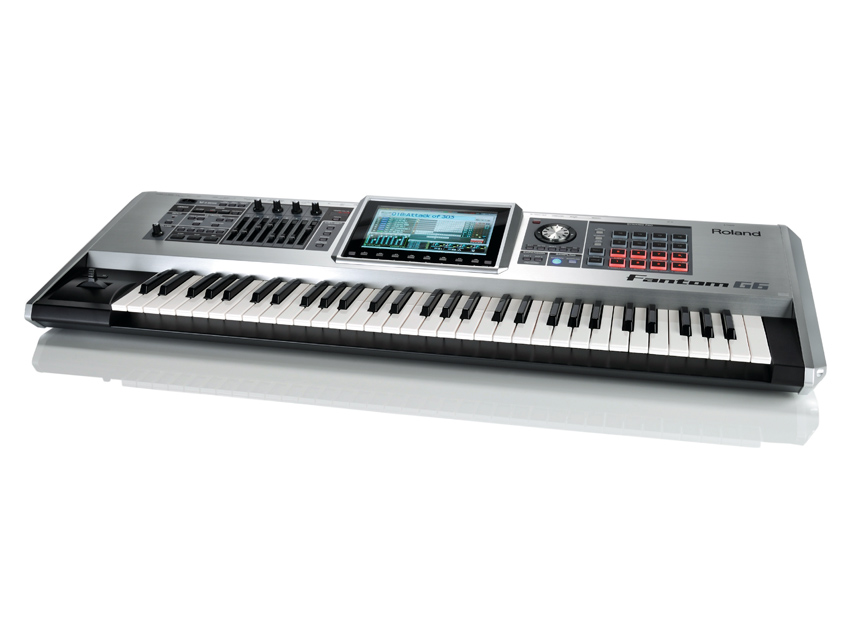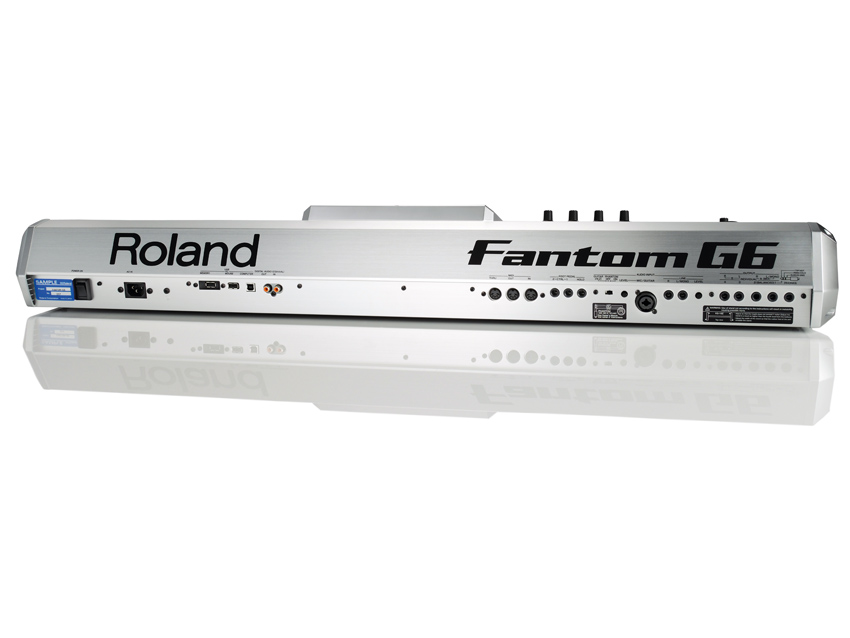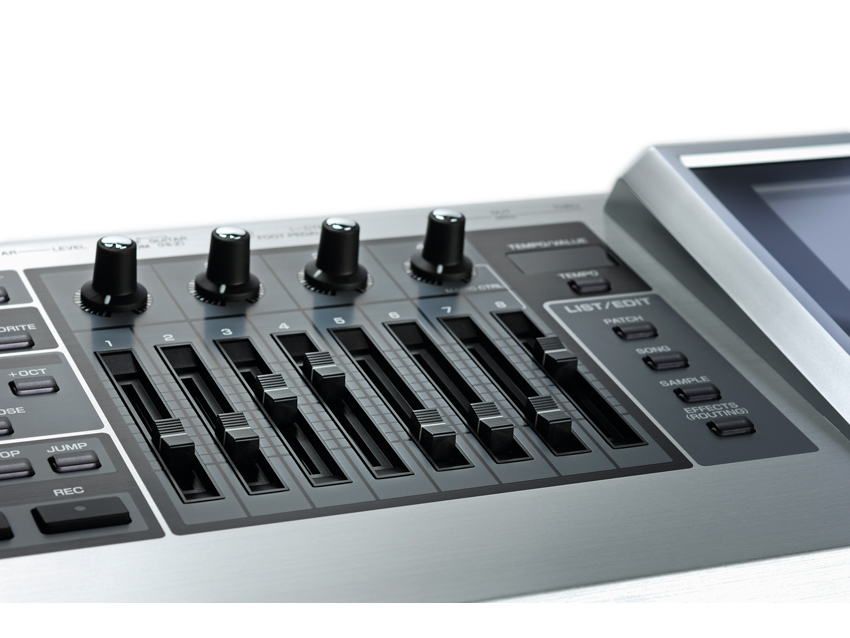MusicRadar Verdict
The Fantom-G6 offers an awful lot under one roof and boasts some intuitive new features.
Pros
- +
Much-improved screen. Part-FX are great. Eight sliders are great for mixing.
Cons
- -
Only 32MB of onboard RAM.
MusicRadar's got your back

Roland Fantom-G6

Roland Fantom-G6

Roland Fantom-G6
Launched at the 2008 Winter NAMM show, the 'G' series Fantom arrives in three forms - G6 (61 keys), G7 (76) and G8 (88). The largest of these features Roland's extremely impressive 'Ivory' keyboard response.
With this release, the Fantom has been improved both internally and externally, with the most obvious improvement being evident before you even switch the machine on. The Fantom-X introduced Roland's colour screen, but this has been expanded up to a whopping 8.5-inch TFT display on the 'G' series and, the moment you do boot up, the benefits are clear.
This display positively sparkles. The increased resolution means that more information can be shown clearly at a smaller size, which means that the display bristles with data. Initially, this might be a touch overwhelming - Roland's desire to keep you updated with as many parameters at once adds up to a packed interface - but you soon get used to it.
To give you an example, the default screen, displaying parameters in Live Mode, provides the names of all eight active parts, with a graphical display of the key ranges over which they play. You can also see graphical representations of the eight new sliders (of which more in a moment), as well as numerical values for these, plus status displays for the four rotary dials, two assignable switches, pitchbend and mod wheels, and the function button title displays.
Roland's clever colour-coding and layout give everything sufficient room, so you're soon navigating like an expert, either via the arrow keys, rotary dial and function keys, or via a USB mouse, which can be connected on the back panel.
Any self-respecting workstation that offers multi-layered parts and mixing in the sequencer section needs the immediacy of sliders, so it's with a sigh of relief that we greet the arrival of eight new ones on the new Fantom. They lie below the four assignable dials to the screen's left and have a nice smooth action.
There's a momentary pause before a slider realises you've given it a nudge and its position in the display adjusts, but this wasn't a problem in mix sessions.
Sounds
Under the hood, there are plenty of developments too. For starters, the Wave ROM has been expanded to 256MB, which is twice that of its predecessor. This translates to a sound engine that boasts 230 individual waveforms and getting on for 2000 internal sounds, including the General MIDI banks.
The new onboard samples are taken from the SRX expansion board series but, more importantly, also feature brand new waveforms. The internal sample capacity is unchanged from the Fantom-X, with 32MB of memory as standard, which is expandable up to 544MB if you choose to fill the spare DIMM slot with extra RAM.
Initially, we found this limited standard provision frustrating and thought Roland had been a bit stingy but we can, to an extent, understand the logic. RAM is cheap, so if you do want to dramatically expand, it won't break the bank to do so. There are also lots of potential Fantom-G users who won't touch the sampling capabilities (though they should!) as they have this base covered somewhere else, so we can understand why Roland would keep this basic level on the low side. However, 64MB would have represented a better compromise in our opinion.
Expansion of a different kind if also possible, as the release of the Fantom-G coincides with the launch of a new range of Roland Expansion cards. We've only had a demo of the ARX boards so far, but they certainly look interesting and sound great.
Two cards are available at present: one for Drums and one for Electric Piano. The technology looks much more interactive than on previous cards, using that big screen's new graphics power to the max.
Sequencing
The Sequencer section has also been given a pretty hefty shot in the arm: it can now handle 128 MIDI tracks and 24 tracks of audio. This is a big improvement over the 'X' series but, for me, the standout new feature is the development of Part-FX.
16 parts can now have their own multi-effects program, alongside the more basic reverb and chorus units that have long been a Roland staple. This is truly great and, to be honest, raises the Fantom from 'also ran' status to 'first past the post' among its workstation peers in the effects stakes.
The sequencer itself is pretty straightforward to use once you've spent a few minutes familiarising yourself with its functionality. If you decide you're going to let your computer continue in its sequencing role, you'll be delighted to hear that you can hook your Fantom-G up via USB to directly interact with it, so that you can remotely edit the it from your computer, or run it as an AU/VST plug-in within your host DAW.
The USB specification is impressive on the Fantom-G, with an extra USB slot enabling you to attach a USB key or hard drive for quick saving or loading of samples, songs, patches and performances.
Summary
There's no question that the new features here bring the Fantom-G up to and, in some respects, way beyond the functionality of its rival workstations. This is an instrument that's capable of doing a job for a whole range of musicians.
Clearly, workstations are the ideal 'live player' companion, with thousands of sounds, effects and performance tricks available at the touch of just a few buttons, with none of the temperament issues many of us still experience when gigging with computers.
A workstation like this is also extremely useful in the studio. Putting demos together with minimum fuss is great, so there's immediate appeal for songwriters.
With the provision of MIDI controller sliders and multiple live sets, there's even a place for a Fantom in the software-based studio, as it's easy to customise a live setup to control your soft synths, or even to integrate the 'G' with your DAW.
Of course, the Fantom-G won't be to everyone's taste, but you'd be a fool to ignore it.
Hear what the Fantom-G can do in these audio clips:
Atmospheric
Dream lead
Landyn's blend
Piano with Phonograph
For a more detailed review of the Fantom-G6, check out issue 200 of Future Music magazine.
MusicRadar is the number 1 website for music makers of all kinds, be they guitarists, drummers, keyboard players, djs or producers...
GEAR: We help musicians find the best gear with top-ranking gear round-ups and high- quality, authoritative reviews by a wide team of highly experienced experts.
TIPS: We also provide tuition, from bite-sized tips to advanced work-outs and guidance from recognised musicians and stars.
STARS: We talk to musicians and stars about their creative processes, and the nuts and bolts of their gear and technique. We give fans an insight into the actual craft of music making that no other music website can.
“Instead of labouring over a perfect recreation, we decided to make an expanded counterpart”: Chase Bliss teams up with Mike Piera for Analog Man collab based on the legendary King Of Tone
“It’s about delivering the most in-demand mods straight from the factory”: Fender hot-rods itself as the Player II Modified Series rolls out the upgrades – and it got IDLES to demo them
“For some reason, the post office shipped your guitar to Jim Root of Slipknot”: Sweetwater mailed a metal fan's Jackson guitar to a metal legend










